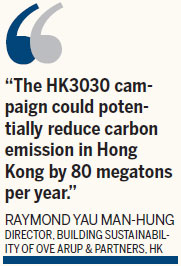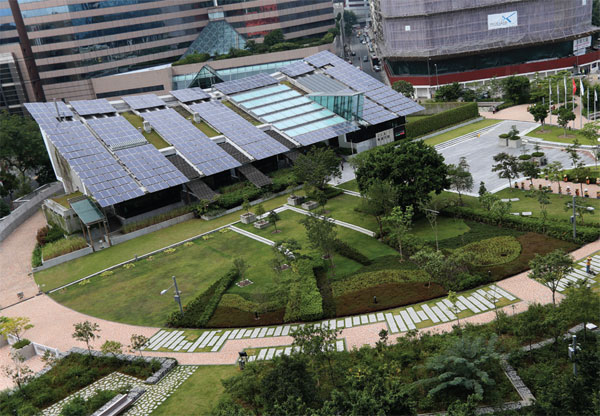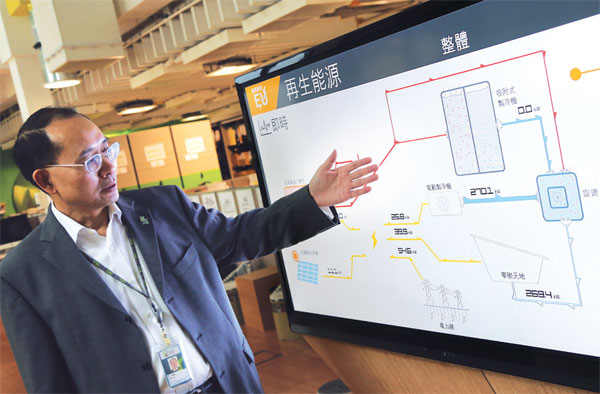Building of the future
Updated: 2014-10-30 07:53
By Sylvia Chang in Hong Kong(HK Edition)
|
|||||||||
Surrounded by a landscape area with more than 200 trees of 40 species, with birds and butterflies dancing on, the Zero Carbon Building (ZCB) appears to be an oasis in the urban concrete jungle. It's a monument to modern architecture, located in the heart of Kowloon Bay, designed in a way to allow sunlight filtering in and the air circulate freely across its corridors.
The southeast facing array of blue, photovoltaic panels coupled with other systems is capable of producing more energy than the building requires, so that ZCB can export power to buildings in the surrounding area.
Inside ZCB is a wide room with wooden floors and deep overhangs towards the south. A big screen in front of the door monitors the concentration of carbon dioxide, keeping track of temperature and humidity. A huge fan spins slowly. Small panels made from perforated mineral tiles are suspended from the ceiling to absorb sound and reduce echo. Tens of office desks are lined up on one side. The skylights are computer controlled. A large pipe with the appearance of a village chimney contains a wind catcher to improve natural ventilation.
The idea behind the design is to protect occupants' health and improve productivity. "It is the beginning of a trend. Some day Hong Kong will become a city equipped with similar green offices," said Li Guiyi, director of ZCB who has over 20 years experience in environmental consultancy.
The switch to eco-friendly office buildings might happen sooner than expected. Secretary for the Environment Wong Kam-sing said, at a forum held by the Hong Kong Green Building Council on October 17, that green building is a global movement and Hong Kong is a leader in Asia in promoting the concept. Wong added that the government will launch a "green policy" next year, urging more buildings to adopt eco-friendly technology.
Hong Kong covers an area of 1,104 square kilometers, home to over 7 million people. Buildings in Hong Kong account for 90 percent of the total electricity consumed in the city and 60 percent of local greenhouse gas emissions.

Switching soon
By 2030 Hong Kong is committed to leveraging buildings like the ZCB to reduce electricity consumption by 30 percent, compared to 2005, as a campaign against global climate change and increasing demand for electricity consumption. The plan is called "HK3030".
"The HK3030 campaign could potentially reduce carbon emission in Hong Kong by 80 megatons per year," said Raymond Yau Man-hung, director of Building Sustainability of Ove Arup and Partners Hong Kong Ltd.
The ZCB was designed by the Construction Industry Council as a model of latest low-carbon designs and technologies. The building uses recycled cooking oil to generate renewable energy and exports surplus energy.
Hong Kong began implementing the Buildings Energy Efficiency Ordinance in 2012, requiring new buildings and those under major renovation to meet minimum energy efficiency standards.
Hong Kong government also uses the Building Environmental Assessment Method, a rating scheme administrated by the Hong Kong Green Building Council to assess buildings in terms of energy use, indoor environmental quality and water use. ZCB got the highest "Platinum" rating.
ZCB has a range of appliances to support eco-friendly living, such as tools for reducing waste and recycling. "These products are specifically designed for a regular 700-square-feet apartment in Hong Kong," said Li of ZCB.
"A green building designed for exhibition is still at the conceptual stage. Only greater public awareness about sustainable living could make these effective," Li said.
sylvia@chinadailyhk.com
|
The blue, photovoltaic panels in ZCB are capable of producing more power than the building requires. Photos By Edmond Tang |
|
Zero Carbon Building director Li Guiyi believes they have set a trend of developing green buildings that are likely to catch on in Hong Kong. |
(HK Edition 10/30/2014 page7)

